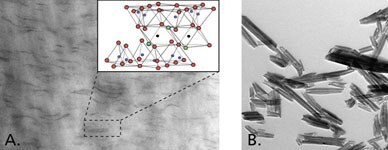Nano Minerals: Nanoclays
Nanoclays are nanoparticles of layered mineral silicates. Depending on chemical composition and nanoparticle morphology, nanoclays are organized into several classes such as montmorillonite, bentonite, kaolinite, hectorite, and halloysite. Organically-modified nanoclays (organoclays) are an attractive class of hybrid organic-inorganic nanomaterials with potential uses in polymer nanocomposites, as rheological modifiers, gas absorbents and drug delivery carriers.
Montmorillonite Nanoclays
Plate-like montmorillonite is the most common nanoclay used in materials applications. Montmorillonite consists of ~ 1 nm thick aluminosilicate layers surface-substituted with metal cations and stacked in ~ 10 µm-sized multilayer stacks. Depending on surface modification of the clay layers, montmorillonite can be dispersed in a polymer matrix to form polymer-clay nanocomposite. Within the nanocomposite individual nm-thick clay layers become fully separated to form plate-like nanoparticles with very high (nm × µm) aspect ratio (Figure 1A). In collaboration with the Nanocor Corporation, we offer a range of montmorillonite nanoclay products with different organic modifications optimized to be compatible with various polymer systems.

Figure 1.A. TEM micrograph of 2% nylon-clay nanocomposite showing nm-thick platelets of montmorillonite clay fully dispersed in the polymer matrix. Inset shows schematic of montmorillonite aluminosilicate layer structure. B. TEM micrograph of halloysite clay nanotubes.
Halloysite Nanoclay
Halloysite is a naturally occurring aluminosilicate nanotube (Figure 1B). The two-layer halloysite tubes are chemically similar to kaoline and have average dimensions of 15 × 1000 nm comparable to carbon nanotubes. Halloysite tubes are hollow and can be used for controlled delivery and release of drugs as well as nanocomposite and rheology modification applications.
Materials
To continue reading please sign in or create an account.
Don't Have An Account?